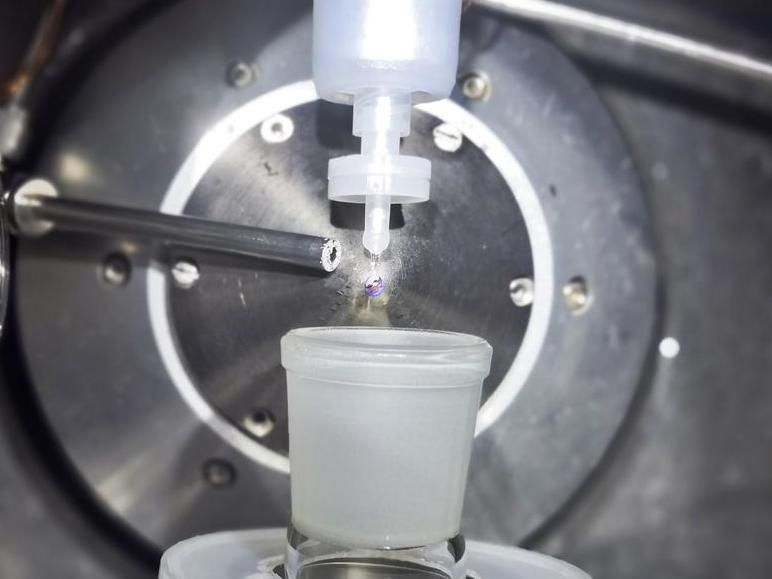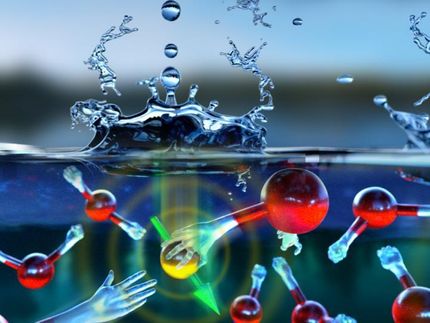Water detected as a metal at BESSY II
Under normal conditions, pure water is an almost perfect insulator. Water only develops metallic properties under extreme pressure, such as exists at most in the interior of large planets. Now, an international collaboration has used a completely different approach to produce metallic water and documented the phase transition at BESSY II. The work has been published in Nature.

In the sample chamber, the NaK alloy drips from a nozzle. Water vapor flows in and forms a thin skin on the drop surface.
HZB
Every child knows that water conducts electricity - but this refers to "normal" everyday water that contains salts. Pure, distilled water, on the other hand, is an almost perfect insulator. It consists of H2O molecules that are loosely cross-linked with each other via hydrogen bonds. In this process, the valence electrons remain bound and are not mobile. To create a conduction band with freely mobile electrons, water would have to be pressurized to such an extent that the orbitals of the outer electrons overlap. However, a calculation shows that this pressure is at most present in the interior of large planets such as Jupiter.
An international collaboration of 15 scientists from eleven research institutions has now used a completely different approach to produce a water solution with metallic properties for the first time and documented this phase transition at BESSY II. For this purpose, they experimented with alkali metals, which give up their outer electron very easily.
However, the chemistry between alkali metals and water is known to be explosive. Sodium or other alkali metals immediately start to burn in water. But the team found a way to keep this violent chemistry in check: Rather than throwing a bit of alkali metal into water, they did it the other way around: they added a tiny bit of water to a drop of alkali metal.
They used a sodium-potassium alloy for this, which is liquid at room temperature. At the beamline U49/2 at BESSY II, they set up the experiment in the SOL³PES high-vacuum sample chamber. The sample chamber contains a very fine nozzle from which the liquid Na-K alloy drips. The silver droplet grows for about 10 seconds until it detaches from the nozzle. As the droplet grows, some water vapor flows into the sample chamber and forms an extremely thin skin on the surface of the droplet, a layer of a few layers of water molecules. Almost immediately, electrons and metal ions migrate from the alkali alloy into the water. These migrated electrons behave like free electrons in a conduction band.
"You can see the phase transition to metallic water with the naked eye!". The silvery sodium-potassium droplet covers itself with a golden glow, which is very impressive," reports Dr. Robert Seidel, who supervised the experiments at BESSY II. The thin layer of gold-coloured metallic water remains visible for a few seconds. This enabled the team led by Prof. Pavel Jungwirth, Czech Academy of Sciences, Prague, to prove with spectroscopic analyses at BESSY II and at the IOCB in Prague that it is indeed water in a metallic state.
The two crucial fingerprints of a metallic phase are the plasmon frequency and the conduction band. The groups were able to determine these two quantities using optical reflection spectroscopy and synchrotron X-ray photoelectron spectroscopy: While the plasmon frequency of the gold-colored metallic "water skin" is about 2.7 eV (i.e., in the blue region of visible light), the conduction band has a width of about 1.1 eV with a sharp Fermi edge. "Our study not only shows that metallic water can indeed be produced on Earth, but also characterizes the spectroscopic properties associated with its beautiful golden metallic luster," says Seidel.
Note: This article has been translated using a computer system without human intervention. LUMITOS offers these automatic translations to present a wider range of current news. Since this article has been translated with automatic translation, it is possible that it contains errors in vocabulary, syntax or grammar. The original article in German can be found here.
Original publication
Philip E. Mason, H. Christian Schewe, Tillmann Buttersack, Vojtech Kostal, Marco Vitek, Ryan S. McMullen, Hebatallah Ali, Florian Trinter, Chin Lee, Daniel M. Neumark, Stephan Thürmer, Robert Seidel, Bernd Winter, Stephen E. Bradforth, and Pavel Jungwirth; "Spectroscopic Evidence for a Gold-Coloured Metallic Water Solution"; Nature (2021).






















































